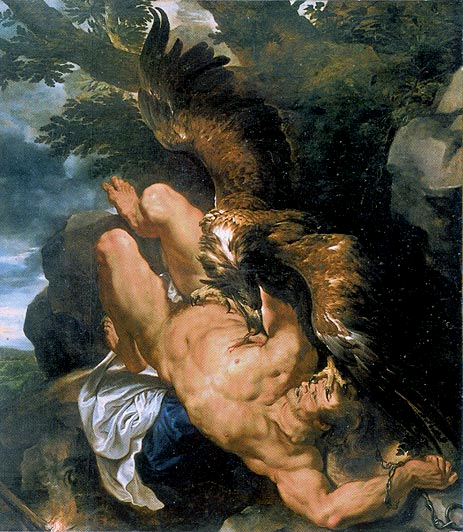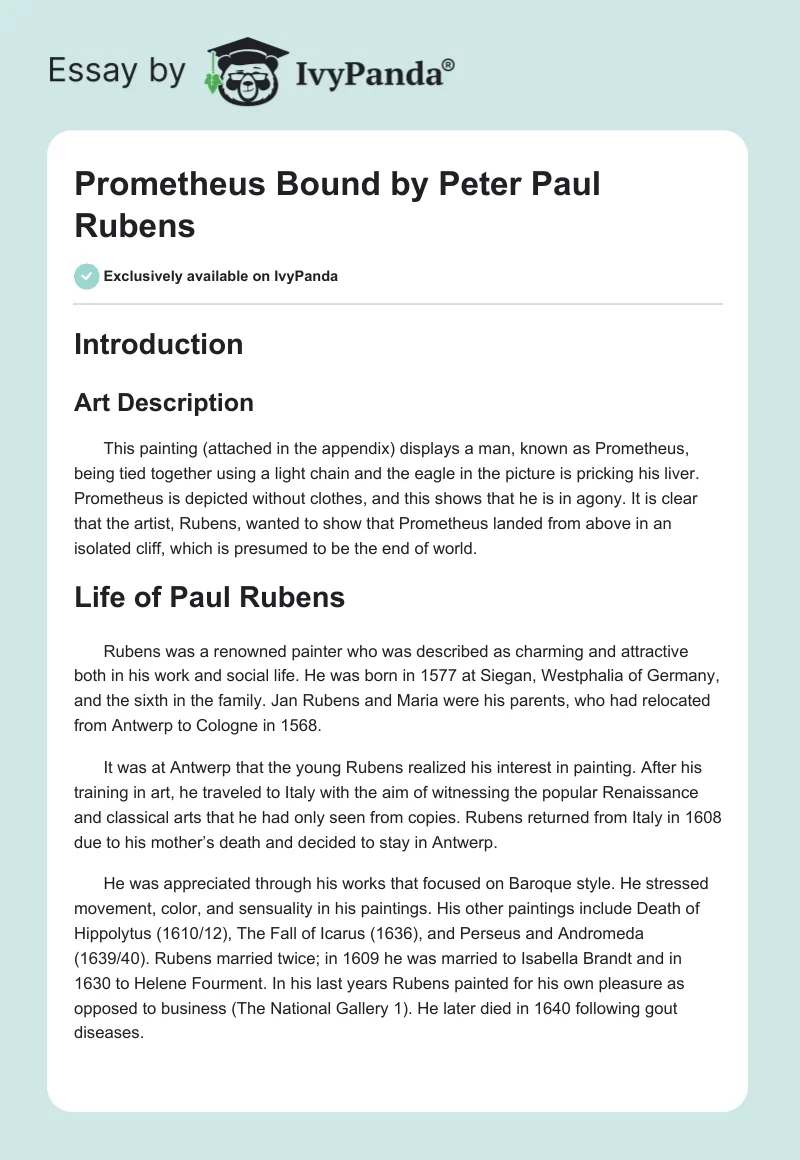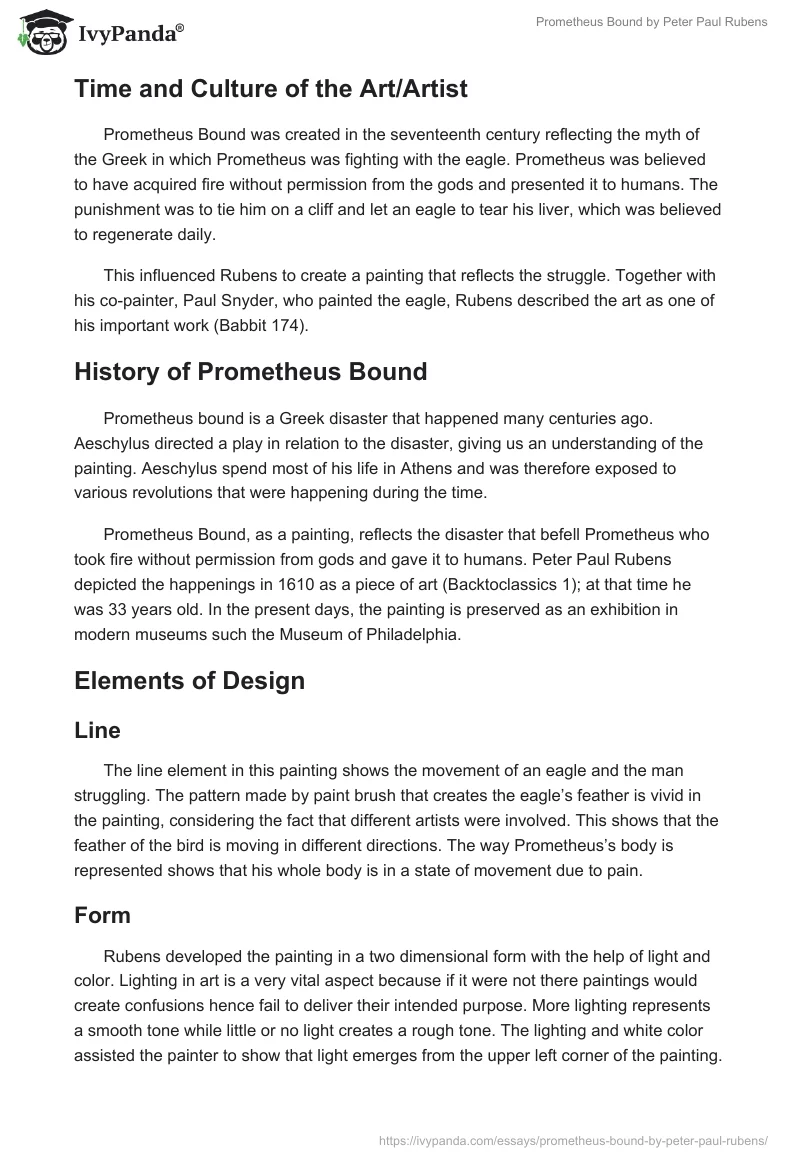Introduction
Art Description
This painting (attached in the appendix) displays a man, known as Prometheus, being tied together using a light chain and the eagle in the picture is pricking his liver. Prometheus is depicted without clothes, and this shows that he is in agony. It is clear that the artist, Rubens, wanted to show that Prometheus landed from above in an isolated cliff, which is presumed to be the end of world.
Life of Paul Rubens
Rubens was a renowned painter who was described as charming and attractive both in his work and social life. He was born in 1577 at Siegan, Westphalia of Germany, and the sixth in the family. Jan Rubens and Maria were his parents, who had relocated from Antwerp to Cologne in 1568.
It was at Antwerp that the young Rubens realized his interest in painting. After his training in art, he traveled to Italy with the aim of witnessing the popular Renaissance and classical arts that he had only seen from copies. Rubens returned from Italy in 1608 due to his mother’s death and decided to stay in Antwerp.
He was appreciated through his works that focused on Baroque style. He stressed movement, color, and sensuality in his paintings. His other paintings include Death of Hippolytus (1610/12), The Fall of Icarus (1636), and Perseus and Andromeda (1639/40). Rubens married twice; in 1609 he was married to Isabella Brandt and in 1630 to Helene Fourment. In his last years Rubens painted for his own pleasure as opposed to business (The National Gallery 1). He later died in 1640 following gout diseases.
Time and Culture of the Art/Artist
Prometheus Bound was created in the seventeenth century reflecting the myth of the Greek in which Prometheus was fighting with the eagle. Prometheus was believed to have acquired fire without permission from the gods and presented it to humans. The punishment was to tie him on a cliff and let an eagle to tear his liver, which was believed to regenerate daily.
This influenced Rubens to create a painting that reflects the struggle. Together with his co-painter, Paul Snyder, who painted the eagle, Rubens described the art as one of his important work (Babbit 174).
History of Prometheus Bound
Prometheus bound is a Greek disaster that happened many centuries ago. Aeschylus directed a play in relation to the disaster, giving us an understanding of the painting. Aeschylus spend most of his life in Athens and was therefore exposed to various revolutions that were happening during the time.
Prometheus Bound, as a painting, reflects the disaster that befell Prometheus who took fire without permission from gods and gave it to humans. Peter Paul Rubens depicted the happenings in 1610 as a piece of art (Backtoclassics 1); at that time he was 33 years old. In the present days, the painting is preserved as an exhibition in modern museums such the Museum of Philadelphia.
Elements of Design
Line
The line element in this painting shows the movement of an eagle and the man struggling. The pattern made by paint brush that creates the eagle’s feather is vivid in the painting, considering the fact that different artists were involved. This shows that the feather of the bird is moving in different directions. The way Prometheus’s body is represented shows that his whole body is in a state of movement due to pain.
Form
Rubens developed the painting in a two dimensional form with the help of light and color. Lighting in art is a very vital aspect because if it were not there paintings would create confusions hence fail to deliver their intended purpose. More lighting represents a smooth tone while little or no light creates a rough tone. The lighting and white color assisted the painter to show that light emerges from the upper left corner of the painting.
Shape
The positive shape within the painting shows Prometheus as occupying a lot of space. His soft tone body is used by the artist to capture the attention of the viewer. In creating the art, Rubens ensured that the major theme of the painting is shown through the boundary that separated the other parts of the cliff and the fire. In addition, the painter does not show everything that can be expected from the background such as trees and so forth. Apart from the tree that is next to Prometheus, there are no trees or bushes on the background.
Value
Light is another aspect that is important in all pieces regardless of their nature. Light is used to influence colors and shadows; light is emerging from the left. This is true because when you first glance at the painting the right side is darker.
Space
The area or space occupied by the painting is clearly represented by the shape of the painting. Rubens main agenda was to represent Prometheus and the eagle in a small space as possible with the visibility of the cliff. It is believed that he later included the landscape and the fire to the artwork. However, it could be too impacted and violent without the additional space.
Color
The skies in this painting have been perfectly blended by creating a balance on the intensity of colors to create a dull mood. If the artist would have injected more blue on to the canvas the skies would have been bright. Alternatively if more white color was injected the result would be clouds that resemble cotton wool that are on top of the blue skies.
Dark colors and light colors of brown, green, and blue have been applied to improve on the contrast of the painting to enable the audience draw a line between the eagle, Prometheus, and the environment.
Texture
The texture on the eagle’s feathers is different in that the part was done by Rubens is not similar to that of Snyder. The eagle’s texture is detailed that that of Prometheus; such effort is essential in painting (Rollins & K.O.S Members 1). Light brown color has been used to add texture on to the eagle’s wings and around its neck.
Principles of Design
Repetition
The painting represents line, color, and tone in more than one place. The line element shows that there is movement from Prometheus and the eagle. The brown color is repeated with different tones to create balance on the painting.
Unity
Color and tone has been used to unify the tree, the rock and the eagle. The painting is neutral because it’s not too bright or too dark. This is crucial because too much or lack of contrast would bring confusion into the painting.
Pattern
The hills on the landscape in this painting have been repeated severally with different intensity to create a pattern. For instance, white color represents the sky and the cloth on the ground.
Emphasis
The line and texture element seem to dominate this painting as compared to form and shape. The movement created by the eagle is much intense as compared to that of Prometheus. He does not seem to be struggling but relaxed. The eagle’s claw in Prometheus’s skin shows the important theme of bounding. But still he is still determined to be released from the bound.
Balance
Balance in this piece is achieved by shading more light on one side of the painting, while darkening the opposite side. The background also is too dark compared to the front which is much lighter thereby balancing the aspect of light and darkness.
Asymmetrical
The colors in this painting look to be directly related. The background of the painting is perfected by combining extreme white with blue. This merge creates a shadow that dominates the painting, thus depicting asymmetrical principle.
Contrast
The different elements of art such as line, color, form, and texture are well represented in the art as described in the previous section.
Proportion
The proportion of this painting is also balanced because the painting seems to occupy almost the whole canvas, with each object well represented in its relative size.
Symmetrical
Formal balance in this painting is not well represented, but if viewed carefully it can be noted that the focus was on the eagle’s beak and Prometheus’s chest. However, his face does not show the agony of a suffering man.
Variety and Rhythm
Variety in this painting is depicted through the incorporation of artistic elements in different degrees. The smooth texture in the painting creates a cool mood. Prometheus’s skin tone is much emphasized and also the eagle’s rear is not visible, thus creating a rhythm. The eagle’s rear has been merged with the tree’s shadow.
Style of Art
Prometheus bound represents a Baroque style of art. In this style, a lot of emphasis is placed on color, movement or line, and sensuality. Clearly the painting shows much sense in regard to the punishment of Prometheus.
This is a typical work of Rubens since most of his paintings represented such themes and style, in which religion was prominent. The painting is similar to the style of other artists, particularly during the Renaissance period. Artist such as Snyder shared the same theme with Rubens in the creation of their artwork (The National Gallery 1).
Artist’s Purpose
The main idea behind this painting was to depict the suffering of Prometheus and the majestic forms of Titian. It is vivid that there still some sort of fight between Prometheus and the eagle. Thus, the concept is well represented through the Baroque style of painting and well representation of the elements of design.
Conclusion
Prometheus bound is an interesting painting because it depicts an extraordinary struggle between man and eagle. I was fascinated with the idea that the man, Prometheus, was a Greek god who stole fire with the aim of saving mankind.
Moreover, the painting itself catches the eye and thus the need to research it. I like the art because it fully depicts what happened to the Titan and the representation of the elements of design. The painting elicits an emotional response because it is not common for man to be punished by an animal but the other way round.
Works Cited
Backtoclassics. Prometheus Bound by Peter Paul Rubens, 1610-1611. 2009. Web.
Babbit, Sherry. Eds. Philadelphia Museum of Art: Handbook of Collections. Philadelphia: Philadelphia Museum of Art, 1995. Print.
Rollins, Tim and K.O.S Members. “What is this fire? Dialogue 2”. Philadelphia Museum of Art. 16 May 1997. Web. <http://awp.diaart.org/kos/dialog2.html>
The National Gallery. Peter Paul Rubens, 1577-1640. London. n.d. Web. <https://www.nationalgallery.org.uk/artists/peter-paul-rubens>
Appendix

Peter Paul Rubens: Prometheus Bound
Source: Backtoclassics. Prometheus Bound by Peter Paul Rubens, 1610-1611. 2009.


